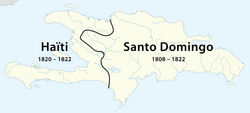Republic of Spanish Haiti Estado Independiente de Haití Español (Spanish) | |||||||||
|---|---|---|---|---|---|---|---|---|---|
| 1821–1822 | |||||||||
 The Republic of Spanish Haiti in the east of Hispaniola | |||||||||
| Status | Unrecognized state | ||||||||
| Capital | Santo Domingo | ||||||||
| Common languages | Spanish | ||||||||
| Demonym(s) | Dominican[1] | ||||||||
| Government | Republic | ||||||||
| President | |||||||||
• 1821–1822 | José Núñez de Cáceres | ||||||||
| Independence | |||||||||
| History | |||||||||
• Independence | 1 December 1821 | ||||||||
• Haitian occupation of Santo Domingo (end of state) | 9 February 1822 | ||||||||
| Currency | Santo Domingo real | ||||||||
| |||||||||
| Today part of | Dominican Republic | ||||||||
The Republic of Spanish Haiti (Spanish: República del Haití Español), also called the Independent State of Spanish Haiti (Estado Independiente del Haití Español)[2][3] was the independent state that succeeded the Captaincy General of Santo Domingo after independence was declared on 30 November 1821 by José Núñez de Cáceres.[4][5] The republic lasted only from 1 December 1821 to 9 February 1822 when it was invaded by the Republic of Haiti.[2]
- ^ "Declaratoria de la independencia del 1821". Retrieved 14 April 2018.
- ^ a b "José Nuñez de Cáceres". Educando.edu.do (in Spanish). 23 March 2007. Archived from the original on 13 May 2014. Retrieved 6 October 2011.
- ^ "De la Ocupación Haitiana a la Independencia". Mundo Dominicano (in Spanish). 23 March 2007. Archived from the original on 10 October 2011. Retrieved 6 October 2011.
- ^ Lancer, Jalisco. "The Conflict Between Haiti and the Dominican Republic". All Empires Online History Community. Retrieved 14 April 2018.
- ^ "Haiti – Historical Flags". Flags of the World. Archived from the original on 5 May 2005. Retrieved 24 December 2007.

